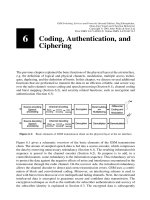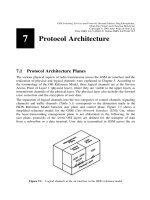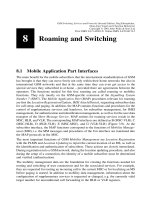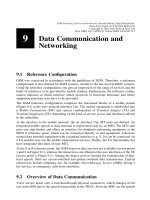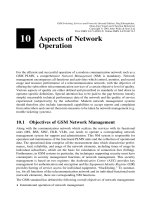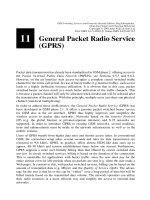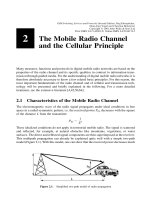GSM switching services and protocols P9
Bạn đang xem bản rút gọn của tài liệu. Xem và tải ngay bản đầy đủ của tài liệu tại đây (650.74 KB, 21 trang )
Data Communication and
Networking
9.1 Reference Con®guration
GSM was conceived in accordance with the guidelines of ISDN. Therefore, a reference
con®guration is also de®ned for GSM systems, similar to the one used in ISDN systems.
Using the reference con®guration, one gets an impression of the range of services and the
kinds of interfaces to be provided by mobile stations. Furthermore, the reference con®g-
uration indicates at which interface which protocols or functions terminate and where
adaptation functions may have to be provided.
The GSM reference con®guration comprises the functional blocks of a mobile station
(Figure 9.1) at the user±networkinterface Um. The mobile equipment is subdivided into
a Mobile Termination (MT) and various combinations of Terminal Adapter (TA) and
Terminal Equipment (TE), depending on the kind of service access and interfaces offered
to the subscriber.
At the interface to the mobile network, the air interface Um, MT units are de®ned. An
integrated mobile speech or data terminal is represented only by an MT0. The MT1 unit
goes one step further and offers an interface for standard-conforming equipment at the
ISDN S reference point, which can be connected directly as end equipment. Likewise,
normal data terminal equipment with a standard interface (e.g. V.24) can be connected via
a TA and this way use the mobile transmission services. Finally, the TA functionality has
been integrated into units of type MT2.
At the S or R reference point, the GSM bearer or data services are available (access points
1 and 2 in Figure 9.1), whereas the teleservices are offered at the user interfaces of the TE
(access point 3, Figure 9.1). Among the bearer services besides the transmission of digi-
tized speech, there are circuit-switched and packet-switched data transmission. Typical
teleservices besides telephony are, for example, Short Message Service (SMS), Group 3
fax service, or emergency calls from anywhere.
9.2 Overview of Data Communication
Voice service needs only a switched-through physical connection, which changes its bit
rate in the BSS due to the speech transcoding in the TRAU. From the MSC on, the speech
9
GSM Switching, Services and Protocols: Second Edition. Jo
È
rg Eberspa
È
cher,
Hans-Jo
È
rg Vo
È
gel and Christian Bettstetter
Copyright q 2001 John Wiley & Sons Ltd
Print ISBN 0-471-49903-X Online ISBN 0-470-84174-5
signals in GSM networks are transported in standard ISDN format with a bit rate of
64 kbit/s. In comparison, realizing data services and the other teleservices like Group 3
fax is considerably more complicated. Because of the psychoacoustic compression proce-
dures of the GSM speech codec, data cannot be simply transmitted as a voiceband signal as
in the analog network± a complete reconstruction of the data signal would not be possible.
Therefore, a solution to digitize the voiceband signal similar to ISDN is not possible.
Rather the available digital data must be transmitted in unchanged digital form by avoiding
speech codecs in the PLMN, as is possible in the ISDN. Here we have to distinguish two
areas where special measures have to be taken: ®rst, the realization of data and teleservices
at the air interface or within the mobile network, and second, at the transition between
mobile and ®xed networkwith the associated mapping of service features. These two areas
are illustrated schematically in Figure 9.2.
A PLMN offers transparent and nontransparent services. These bearer services carry data
between the MT of the mobile station and the Interworking Function (IWF) of the MSC.
For the realization of bearer services, the individual units of the GSM networkde®ne
several functions:
9 Data Communication and Networking
210
Figure 9.1: GSM reference con®guration
² Bit Rate Adaptation (RA)
² Forward Error Correction (FEC)
² ARQ error correction with the Radio Link Protocol (RLP)
² Adaptation protocol Layer 2 Relay (L2R)
For the transmission of transparent and nontransparent data, several rate adaptation stages
are required to adapt the bit rates of the bearer services to the channel data rates of the radio
interface (traf®c channels with 3.6 kbit/s, 6 kbit/s, and 12 kbit/s) and to the transmission
rate of the ®xed connections. A bearer service for data transmission can be realized in the
following two ways: 9.6 kbit/s data service requires a full-rate traf®c channel, all other data
services can either be realized on a full-rate or half-rate channel. A mobile station must
support both types of data traf®c channels, independent of what is used for speech trans-
mission. The data signals are transcoded ®rst from the user data rate (9.6 kbit/s, 4.8 kbit/s,
2.4 kbit/s, etc.) to the channel data rate of the traf®c channel, then further to the data rate of
the ®xed connection between BSS and MSC (64 kbit/s) and ®nally back to the user data
rate. This bit rate adaptation (RA) in GSM corresponds in essence to the bit rate adaptation
in the ITU-T standard V.110, which speci®es the support of data terminals with an inter-
face according to the V. series on an ISDN network[34].
On the radio channel, data is protected through the forward error correction procedures
(FEC) of the GSM PLMN; and for nontransparent data services, data is additionally
protected by the ARQ procedure of RLP on the whole networkpath between MT and
MSC. Thus RLP is terminated in the MT and MSC. The protocol adaptation to RLP of
Layers 1 and 2 at the user interface is done by the Layer 2 Relay (L2R) protocol.
Finally, the data is passed on from MSC or GMSC over an Interworking Function (IWF) to
the respective data connection. The bearer services of the PLMN are transformed to the
bearer services of the ISDN or another PLMN in the IWF, which is usually activated in an
MSC near the MS, but could also reside in the GMSC of the networktransition. In the case
of ISDN this transition is relatively simple, since it may just require a potential bit rate
adaptation. In the case of an analog PSTN, the available digital data must be transformed
by a modem into a voiceband signal, which can then be transmitted on an analog voiceband
of 3.1 kHz.
The bearer services realized in this way can offer the protocols that may be required for the
support of teleservices between TE and IWF. An example is the fax adaptation protocol.
9.2 Overview of Data Communication
211
Figure 9.2: Bearer services, interworking, and teleservices
The fax adapter is a special TE which maps the Group 3 fax protocols with their analog
physical interface upon the digital bearer services of a GSM PLMN. Thus, after another
adaptation into an analog fax signal in the IWF of the MSC, it enables the end-to-end
transfer of fax messages according to the ITU-T Standard T.30.
A possible interworking scenario for transparent data services of GSM with transition to a
PSTN is shown in Figure 9.3. The analog circuit-switched connection of the PSTN repre-
sents a transparent channel which can be used to transport arbitrary digital data signals in
the voiceband. In the analog network, a subscriber selects telephone or modem depending
on whether he or she wants to transmit speech or data. In the PLMN, however, the channel
coding has to be changed for different services (error protection for different bearer
services, see Section 6.2). The bit rate adaptation has to be activated and the speech coding
deactivated. In the IWF of the MSC, besides the bit rate adaptation, a modem needs to be
added for data communication with the partner in the ®xed network. In the GSM network,
voice signals therefore take a different path than data signals; in the case shown in Figure
9.3, the data signals are directed from the IWF to the modem, where they are digitized,
then passed on after bit rate adaptation to transmission on the radio channel. In the opposite
direction, the IWF passes the PCM-coded information on an ISDN channel (64 kbit/s) to
the GMSC. From there it is transformed into an analog signal in a networktransition
switching unit and carried as a voiceband signal in the PSTN to the analog terminal.
After these introductory remarks, the GSM data and teleservices and their realization are
discussed in more detail in the following sections.
9.3 Service Selection at Transitions between Networks
A speci®c interworking problem arises for data services between PLMN and ISDN/PSTN
networks. Mobile-terminated calls require that the calling subscriber (ISDN or PSTN
subscriber) tells the GMSC which service (speech, data, fax, etc.) he or she wants to
use. In ISDN, a Bearer Capability (BC) information element would have to be included
in the setup message. This BC information element could then be passed on by the
9 Data Communication and Networking
212
Figure 9.3: Interworking scenario PLMN-PSTN for transparent data services
networktransition switching unit to the GMSC and from there to the local MSC, which
could thus activate the required resources. In the course of call processing (CC, see Section
7.4.5), the mobile station would also be informed about the kind of service requested by the
calling subscriber and could activate the needed functions. The calling subscriber,
however, if there is no ISDN signaling as in analog networks, is not able to do this kind
of BC signaling. The service selection therefore has to use another mechanism. The GSM
standard proposes two possible solutions, which are always to be used for service selection
independent of the type of originating network(ISDN or PSTN).
² Multinumbering: the home networkwith this option assigns to each mobile subscriber
several MSISDN numbers, each with a speci®c Bearer Capability (BC), which can be
obtained at each call from the HLR. This way the service that an incoming call wants is
always uniquely determined. The BC information element is given to the mobile station
when the call is being set up, so the MS can decide based on its technical features
whether it wants to accept the call.
² Single numbering: only a single MSISDN is assigned to the mobile subscriber, and there
is no BC information element transmitted with an incoming call. The MS recognizes
then that a speci®c BC is needed when a call is accepted and requests the BC from the
MSC. If the networkis able to offer the requested service, the call is switched through.
Usually, the multinumbering solution is favored, since one can already verify at call arrival
time in the MSC whether the requested resources are available, and the MSC side can
decide about accepting the call. There is no negotiation about the BC between MS and
MSC, so no radio resources are occupied unnecessarily, and the call set-up phase is not
extended.
9.4 Bit Rate Adaptation
Five basic traf®c channels are available in GSM for the realization of bearer services:
TCH/H2.4, TCH/H4.8, TCH/F2.4, TCH/F4.8, TCH/F9.6 (see Tables 5.2 and 6.2) with bit
rates of 3.6 kbit/s, 6 kbit/s, and 12 kbit/s. In recent standardization efforts, a TCH/F14.4
has also been de®ned. The bearer services (Table 4.2) with bit rates from 300 bit/s up to
9.6 kbit/s must be realized on these traf®c channels. Furthermore, on the ®xed connections
of the GSM network, the data signals are transmitted with a data rate of 64 kbit/s.
The terminals connected at reference point R have the conventional asynchronous and
synchronous interfaces. The data services at these interfaces workat bit rates as realized by
GSM bearer services. Therefore, the data terminals at the R reference point have to be bit
rate adapted to the radio interface. This bit rate adaptation is derived from the V.110
standard used in ISDN in which the bit rates of the synchronous data streams are going
through a two-step procedure; ®rst, frames are formed at an intermediate rate which is a
multiple of 8 kbit/s; this stream is converted to the channel bit rate of 64 kbit/s [7]. The
asynchronous services are preprocessed by a stuf®ng procedure using stop bits to form a
synchronous data stream.
A V.110 procedure modi®ed according to the requirements of the air interface is also used
in GSM. In essence, GSM performs a transformation of the data signals from the user data
rate (e.g. 2.4 kbit/s or 9.6 kbit/s) at the R reference point to the intermediate data rate
9.4 Bit Rate Adaptation
213
(8 kbit/s or 16 kbit/s) and ®nally to the ISDN bit rate of 64 kbit/s. The adaptation function
from user to intermediate rate is called RA1; the adaptation function from intermediate rate
to ISDN is called RA2. A GSM-speci®c bit rate adaptation step is added between the
intermediate rate and the channel data rate (3.6 kbit/s, 6 kbit/s, or 12 kbit/s) of the traf®c
channel at the reference point Um of the air interface. This adaptation function from
intermediate to channel bit rate is designated as RA1/RA1
0
. An adaptation function
RA1
0
performs the direct adaptation from user to channel data rate without going through
the intermediate data rate. Table 9.1 gives an overview of the bit rates at the reference
points and the intermediate data rates between the RA modules.
Adaptation frames are de®ned for the individual bit rate adaptation steps. These frames
contain signaling and synchronization data besides the user data. They are de®ned based
on V.110 frames, and one distinguishes three types of GSM adaptation frames according to
their length (36 bits, 60 bits, and 80 bits) as shown in Figures 9.4 and 9.5.
The conversion of data signals from user to intermediate rate in the RA1 stage uses the
regular 80-bit frame of the V.110 standard. In this adaptation step, groups of 48 user data
bits are supplemented with 17 ®ll bits and 15 signaling bits to form an 80-bit V.100 frame.
Because of the ratio 0.6 of user data to total frame length, this adaptation step converts user
data rates of 4.8 kbit/s into 8 kbit/s and from 9.6 kbit/s to 16 kbit/s. All user data frames of
less then 4.8 kbit/s are ``in¯ated'' to a data signal of 4.8 kbit/s by repeating the individual
data bits; for example, a 2.4 kbit/s signal all bits are doubled, or with a 600 bit/s signal the
bits are written eight times into an RA1 frame.
At the conversion of the intermediate data rate to the channel data rate in the RA1/RA1
stage, the 17 ®ll bits and 3 of the signaling bits are removed from the RA1 frame, since they
are only used for synchronization and not needed for transmission across the air interface.
This yields a modi®ed V.100 frame of length 60 bits (Figure 9.5), and the data rate is
adapted from 16 kbit/s to 12 kbit/s or from 8 kbit/s to 6 kbit/s, respectively.
9 Data Communication and Networking
214
Table 9.1: Data rates for GSM bit rate adaptation
Interface Data rate (kbit/s) Interface (kbit/s)
User Intermediate Radio S
Reference point R ± Um S
RA1 #2.4 8
RA1 4.8 8
RA1 9.6 16
RA2 8 64
RA2 16 64
RA1/RA1
0
8 3.6
RA1/RA1
0
86
RA1/RA1
0
16 12
In the case of user data rates of 4.8 kbit/s or 9.6 kbit/s, adaptation to the channel data rate
is already complete. Only for user data rates of less than 4.8 kbit/s do additional parts of
the multiple user bits need to be removed, which results in a modi®ed V.110 frame of
36 bits. Thus the user data rates of less than 4.8 kbit/s are adapted to a channel data rate of
3.6 kbit/s. The user data bits of a 2.4 kbit/s signal are then not transmitted twice anymore,
or the 600 bit/s user data signals are only written four times into the frames of the RA1
0
stage. This is, however, only true for the transparent bearer services. For the nontranspar-
ent bearer services, the modi®ed 60-bit V.110 frame is used completely for the transmis-
sion of the 60 data bits of an RLP PDU. The required signaling bits are multiplexed with
user data into the RLP frame through the Layer 2 Relay protocol L2R.
The modem used for communication over the PSTN resides in the IWF of the MSC, since
data is transmitted from here on in digital form within the PLMN. For congestion and ¯ow
9.4 Bit Rate Adaptation
215
Figure 9.4: V.110 80-bit adaptation frame for the RA1 stage
Figure 9.5: Modi®ed V.110 adaptation frame for the RA1
0
stage
control and other functions at the modem interface, the interface signals must therefore be
carried from the modem through the PLMN to the mobile station. For this purpose,
signaling bits are reserved in the frames of the bit rate adaptation function, which represent
these signals and thus give the MS direct modem control. The connection of such a bearer
service is therefore transparent not only for user data, but also for out-of-band signaling of
the (serial) modem interface in the IWF.
9.5 Asynchronous Data Services
Asynchronous data transmission based on the V. and X. series interfaces is widespread in
®xed networks. In order to support such ``non-GSM'' interfaces, the mobile station can
include a Terminal Adapter (TA) over which standard terminals with a V. or X. interface
(e.g. V.24) can be connected. Such an adaptation unit can also be integrated into the mobile
station (MT2, Figure 9.1).
Flow control between TA and IWF can be supported in different ways, just as in ISDN:
² No Flow Control: It is handled end-to-end in higher protocol layers (e.g. transport layer)
² Inband Flow Control with X-ON/X-OFF protocol
² Out-of-Band Flow Control according to V.110 through interface leads 105 and 106.
9.5.1 Transparent Transmission in the Mobile Network
In the case of transparent transmission, data is transmitted with pure Layer 1 functionality.
Besides error protection at the air interface, only bit rate adaptations are performed.
User data is adapted to the traf®c channel at the air interface according to the data rate and
protected with forward error-correcting codes (FECs) against transmission errors. As an
example, Figure 9.6 shows the protocol model for transparent asynchronous data transmis-
sion over an MT1 with an S interface. Data is ®rst converted in the TE1 or TA into a
synchronous data stream by bit rate adaptation (stage RA0). In further stages, data rates are
adapted with an MT1 to the standard ISDN (RA1, RA2), and then converted in MT1 over
RA2, RA1, and RA1
0
to the channel bit rate at the air interface. Provided with an FEC, the
data is transmitted and then converted again in the BSS by the inverse operations of bit rate
adaptation to 64 kbit/s at the MSC interface. But much more frequently than an MT1 with
an (internal) S interface, mobile stations realize a pure R interface without internal conver-
sion to the full ISDN rate in the RA2 stage. This avoids the bit rate adaptation step RA2
and thus the conversion to the intermediate data rate in the RA1 stage. The signal is
converted immediately after the asynchronous±synchronous conversion in the RA0
stage from the user data rate to the channel data rate (stage RA1
0
).
A variation without terminal adapter is shown schematically in Figure 9.7. Here the
complete interface functionality, Interface Circuit (I/Fcct), for a serial V. interface is
integrated with the required adaptation units. The data signals D are converted into a
synchronous signal in MT2 (RA0), packed into a modi®ed V.100 frame together with
signaling information S from the V.-interface, and adapted to the channel data rate
(RA1
0
). After FEC, the data signals are transmitted over the air interface and ®nally
9 Data Communication and Networking
216
